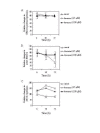Induced cytoskeletal changes in bovine pulmonary artery endothelial cells by resveratrol and the accompanying modified responses to arterial shear stress
- PMID: 11178103
- PMCID: PMC29066
- DOI: 10.1186/1471-2121-2-1
Induced cytoskeletal changes in bovine pulmonary artery endothelial cells by resveratrol and the accompanying modified responses to arterial shear stress
Abstract
Background: Atherosclerosis and coronary heart disease (CHD) are significant contributors to morbidity and mortality in developed countries. A noted exception is the low mortality of CHD in France, particularly the southwest region. This phenomenon, commonly referred to as the French paradox, may be associated with high consumption of red wine. We investigate whether the cardioprotective activity of red wine may involve the grape skin-derived polyphenol, resveratrol. We further test the possibility that resveratrol acts by modulating structural and functional changes in endothelial cells lining the blood vessel wall.
Results: Bovine pulmonary artery endothelial cells (BPAEC) were incubated with resveratrol, with and without concurrent exposure to simulated arterial shear stress. Resveratrol significantly affected proliferation and shape of BPAEC; growth was suppressed and cells became elongated, based on morphologic analysis of rhodamine-conjugated phalloidin stained F-actin by confocal microscopy. Using selective signaling inhibitors, we showed that the resveratrol-induced cellular phenotype was dependent on intracellular calcium and tyrosine kinase activities, and assembly of actin microfilaments and microtubules, but was unrelated to PKC activity. Exposure to simulated arterial flow revealed that, whereas controls cells easily detached from the culture support in a time-dependent manner, resulting in total cell loss after a 5 min challenge with simulated arterial flow conditions, a significant percentage of the treated cells remained attached to the cultured plastic coverslips under identical experimental conditions, suggesting that they adhered more strongly to the surface. Western blot analysis shows that whereas cells treated with 25 microM and 100 microM resveratrol had no change in total ERK1/2, treatment did result in an increase in phosphorylated ERK1/2, which probably involved stabilization of the active enzyme. An increase in nitric oxide synthase expression was detected as early as 6 h and persisted for up to 4 days of treatment.
Conclusions: Results of our studies show that resveratrol interacts with endothelial cells in vitro to elicit morphological and structural changes; the observed changes support the interpretation that resveratrol acts as a cardioprotective agent.
Figures






Similar articles
-
Resveratrol increases nitric oxide synthase, induces accumulation of p53 and p21(WAF1/CIP1), and suppresses cultured bovine pulmonary artery endothelial cell proliferation by perturbing progression through S and G2.Cancer Res. 1999 Jun 1;59(11):2596-601. Cancer Res. 1999. PMID: 10363980
-
Resveratrol and estradiol rapidly activate MAPK signaling through estrogen receptors alpha and beta in endothelial cells.J Biol Chem. 2005 Mar 4;280(9):7460-8. doi: 10.1074/jbc.M411565200. Epub 2004 Dec 22. J Biol Chem. 2005. PMID: 15615701
-
Mechanisms of shear stress-induced endothelial nitric-oxide synthase phosphorylation and expression in ovine fetoplacental artery endothelial cells.Biol Reprod. 2004 Mar;70(3):785-96. doi: 10.1095/biolreprod.103.022293. Epub 2003 Nov 19. Biol Reprod. 2004. PMID: 14627548
-
Mechanism of cardioprotection by resveratrol, a phenolic antioxidant present in red wine (Review).Int J Mol Med. 2001 Jul;8(1):3-17. doi: 10.3892/ijmm.8.1.3. Int J Mol Med. 2001. PMID: 11408943 Review.
-
Mechanotransduction in endothelial cells: temporal signaling events in response to shear stress.J Vasc Res. 1997 May-Jun;34(3):212-9. doi: 10.1159/000159225. J Vasc Res. 1997. PMID: 9226303 Review.
Cited by
-
Morphological analysis of tumor cell/endothelial cell interactions under shear flow.J Biomech. 2007;40(2):335-44. doi: 10.1016/j.jbiomech.2006.01.001. Epub 2006 Feb 23. J Biomech. 2007. PMID: 16497312 Free PMC article.
-
Pro-angiogenic effects of resveratrol in brain endothelial cells: nitric oxide-mediated regulation of vascular endothelial growth factor and metalloproteinases.J Cereb Blood Flow Metab. 2012 May;32(5):884-95. doi: 10.1038/jcbfm.2012.2. Epub 2012 Feb 8. J Cereb Blood Flow Metab. 2012. PMID: 22314268 Free PMC article.
-
Age Impaired endothelium-dependent vasodilation is improved by resveratrol in rat mesenteric arteries.J Exerc Nutrition Biochem. 2016 Mar 31;20(1):41-8. doi: 10.20463/jenb.2016.03.20.1.2. J Exerc Nutrition Biochem. 2016. PMID: 27298812 Free PMC article.
-
Resveratrol: French paradox revisited.Front Pharmacol. 2012 Jul 17;3:141. doi: 10.3389/fphar.2012.00141. eCollection 2012. Front Pharmacol. 2012. PMID: 22822401 Free PMC article.
-
Effects of resveratrol on proliferation and apoptosis in rat ovarian theca-interstitial cells.Mol Hum Reprod. 2010 Apr;16(4):251-9. doi: 10.1093/molehr/gaq002. Epub 2010 Jan 12. Mol Hum Reprod. 2010. PMID: 20067985 Free PMC article.
References
-
- Strong JP, Malcom GT, McMahan CA, Tracey RE, Newman WP, III, Herderick EE, Cornhill JF. Prevalence and extent of atherosclerosis in adolescents and young adults. Implications for prevention from the pathobiological determinants of atherosclerosis in youth study. J Am Med Assoc. 1999;281:727–735. doi: 10.1001/jama.281.8.727. - DOI - PubMed
-
- Gutstein WH. Vasopasm, vascular injury, and atherogenesis: A perspective. Hum Pathol. 1999;30:365–371. - PubMed
-
- Bronte-Stewart B. The role of dietary fats in ischemic heart disease. Br Med Bull. 1958;34:243–251. - PubMed
Publication types
MeSH terms
Substances
LinkOut - more resources
Full Text Sources
Miscellaneous

